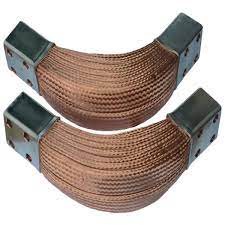In the realm of electrical systems, the symbiotic relationship between Bus Bars and Flexbraid stands as a cornerstone for optimizing efficiency, reliability, and safety in grounding solutions. Understanding their roles, advantages, and applications within grounding systems is pivotal for engineers, industries, and enthusiasts alike seeking to elevate their electrical setups to unprecedented levels of performance and resilience.
Understanding the Dynamic Duo: Bus Bars and Flexbraid in Grounding
Grounding systems, pivotal for safety and operational integrity, rely on the synergy between Bus Bars and Flexbraid to establish secure electrical pathways and dissipate potentially harmful currents. Bus Bars, serving as robust conductors, ensure efficient power distribution and serve as the backbone of grounding networks. Meanwhile, Flexbraid, with its intricate braided structure, provides flexibility and resilience, adapting to varied contours and minimizing electromagnetic interference (EMI).
Enhancing Grounding Efficacy with Bus Bars
Bus Bars, crafted from high-conductivity materials like copper or aluminum, offer substantial current-carrying capacities and structural stability. Their rigid yet conductive nature enables them to efficiently channel currents, establish reliable connections, and mitigate electrical noise. Within grounding setups, Bus Bars excel in distributing fault currents, mitigating voltage fluctuations, and ensuring the integrity of electrical pathways.
The Flexibility and Adaptability of Flexbraid in Grounding Solutions
Flexbraid, a testament to adaptability and resilience, presents a mesh of fine wires intricately braided together. This structural marvel bestows Flexbraid with remarkable flexibility, allowing it to contour and adapt to irregular shapes or confined spaces within grounding setups. Its inherent ability to suppress EMI and provide supplementary conductivity makes Flexbraid an invaluable asset in applications requiring vibration resilience, intricate routing, and versatile grounding solutions.
Elevating Grounding Systems: Applications and Best Practices
Industrial and Commercial Grounding Excellence
In industrial settings where electrical noise and vibration are prevalent, the marriage of Bus Bars and Flexbraid offers an ideal grounding solution. Bus Bars, serving as sturdy conductors, ensure robust connections while Flexbraid adapts to machinery contours, minimizing EMI and fortifying operational stability. In commercial establishments, where space optimization is crucial, Flexbraid’s pliability aids in establishing efficient and adaptable grounding networks.
Flexbraid: The Champion in Compact Electronics
For compact electronics, Flexbraid emerges as the unsung hero, providing the much-needed flexibility and EMI suppression. Within these intricate systems, Flexbraid navigates tight spaces, contours, and movement-prone environments, ensuring reliable grounding and reducing the risk of electrical interference.
Bus Bars and Flexbraid: Pioneering Grounding Excellence
Innovations in grounding systems are witnessing a paradigm shift, propelled by the synergy between Bus Bars and Flexbraid. Their amalgamation not only ensures efficient power distribution and adaptability but also fosters a robust and secure electrical infrastructure. Whether in heavy industrial machinery or compact electronic setups, their collective prowess elevates grounding systems to unprecedented levels of reliability and performance.
Future-Proofing Electrical Infrastructures with Bus Bars and Flexbraid
The future of grounding systems lies in the seamless integration and optimization of Bus Bars and Flexbraid. Advancements in materials, manufacturing techniques, and system designs will further enhance their capabilities, catering to evolving electrical demands across industries. By harnessing the strengths of Bus Bars’ stability and Flexbraid’s adaptability, industries can fortify their grounding systems against emerging challenges and ensure sustained operational efficiency.
Conclusion: Uniting Strength and Flexibility for Unparalleled Grounding
The union of Bus Bars and Flexbraid within grounding systems epitomizes a harmonious balance between stability and adaptability. As industries continue to evolve and demand more resilient electrical infrastructures, harnessing the combined strengths of these stalwarts becomes imperative. The key to optimizing grounding systems lies in understanding their capabilities, leveraging their advantages, and embracing their collaborative potential to forge a future where reliability, efficiency, and safety reign supreme in electrical grounding.
This article strives to dive into the symbiotic relationship between Bus Bars and Flexbraid within grounding systems, aiming to illuminate their roles, advantages, and applications. This comprehensive exploration not only elucidates their individual strengths but also showcases the synergistic prowess they offer when integrated into grounding solutions, ensuring optimal performance and reliability in diverse electrical setups.

